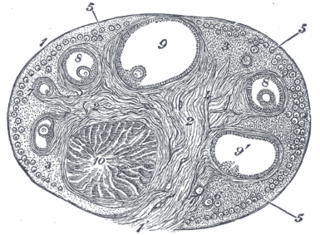Reinke crystals are rod-like cytoplasmic inclusions which can be found in Leydig cells of the testes. [1] Occurring only in adult humans and wild bush rats, their function is unknown. [2]

Leydig cells, also known as interstitial cells of Leydig, are found adjacent to the seminiferous tubules in the testicle. They produce testosterone in the presence of luteinizing hormone (LH). Leydig cells are polyhedral in shape, display a large prominent nucleus, an eosinophilic cytoplasm and numerous lipid-filled vesicles.

The bush rat is a small Australian nocturnal animal. It is an omnivore and one of the most common indigenous species of rats on the continent, found in many heathland areas of Victoria and New South Wales.
Ovarian stromal tumors having a predominant pattern of fibroma or thecoma but also containing cells typical of steroid hormone-secreting cells were reported. Some of the tumors were classified as luteinized thecomas because the steroid cells resembled lutein cells and lacked crystalloids of Reinke. But others were classified as stromal Leydig cell tumors as seen in tumors of the testes because Reinke crystalloids were identified in the steroid cells. The Stromal Leydig tumors occurred at an average age of 61 years and were associated with Ovarian hyperandrogenism which led to virilization in some cases, endometrial hyperplasia in other cases, and endometrial hyperplasia with carcinoma in the rest of the cases. Luteinized thecomas and stromal Leydig cell tumors are indistinguishable except for the presence of crystalloids of Reinke in the latter. In view of the prolonged search that is necessary to find these structures in some stromal Leydig cell tumors and their well-known absence in the majority of testicular Leydig cell tumors, it is reasonable to assume that an unknown proportion of tumors in the luteinized thecoma category are unrecognized stromal Leydig cell tumors. [3] [4]
Another ovarian tumor where Reinke crystalloids were noted is the Brenner tumour, an epithelial-stromal ovarian tumor distinguishable by nests of transitional epithelial cells (urothelial) with longitudinal nuclear grooves (coffee bean nuclei) in abundant fibrous stroma. [5]

Brenner tumors are an uncommon subtype of the surface epithelial-stromal tumor group of ovarian neoplasms. The majority are benign, but some can be malignant.
Also recall that the "coffee bean nuclei" are the nuclear grooves exceptionally pathognomonic to the sex cord stromal tumor, the ovarian granulosa cell tumor, with the fluid-filled spaces Call-Exner bodies between the granulosa cells.

Call–Exner bodies, giving a follicle-like appearance, are small eosinophilic fluid-filled punched out spaces between granulosa cells. The granulosa cells are usually arranged haphazardly around the space.
They are large enough to be seen in an optical microscope and can be visualized using Giemsa, trichrome, Gram, and PAS stains. [6] Reinke crystals are rare in normal testes, but are found in approximately 1/3 of all Leydig cell tumours. [7]

The optical microscope, often referred to as the light microscope, is a type of microscope that commonly uses visible light and a system of lenses to magnify images of small objects. Optical microscopes are the oldest design of microscope and were possibly invented in their present compound form in the 17th century. Basic optical microscopes can be very simple, although many complex designs aim to improve resolution and sample contrast. Often used in the classroom and at home unlike the electron microscope which is used for closer viewing.

Giemsa stain, named after German chemist and bacteriologist Gustav Giemsa, is used in cytogenetics and for the histopathological diagnosis of malaria and other parasites.

Leydig cell tumour, also Leydig cell tumor, (testicular) interstitial cell tumour and (testicular) interstitial cell tumor, is a member of the sex cord-stromal tumour group of ovarian and testicular cancers. It arises from Leydig cells. While the tumour can occur at any age, it occurs most often in young adults.
These crystals are named after the German anatomist Friedrich Berthold Reinke. [8]

Friedrich Reinke was a German anatomist. Reinke crystals, Reinke's space and Reinke's edema are named after him.










